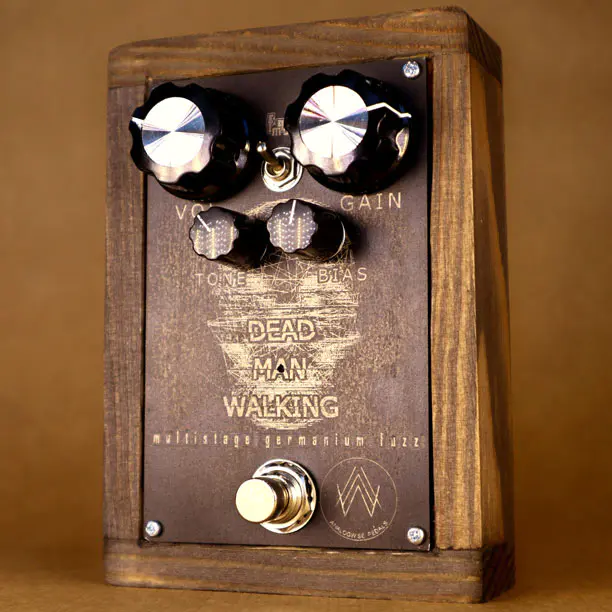
Born from the need to create a fuzz pedal that was gnarly yet retained some smoothness and clarity, the Analogwise Pedals Dead Man Walking is a mid-gain fuzz enclosed in the company’s unmistakable dark wood and unpolished metal signature case.
Hand built in Polland, this is a rather tweakable device, with the two expected knobs for Volume and Gain, and also controls for Bias (setting the fuzz’s texture) and Tone.
The switch in the middle is a “Fat Mod” introducing more low end to the fuzz.
The Dead Man Walking as some sort of sibling pedal that shares part of the circuit but has a lot more gain, the Eat Your Heart Out.
Analogwise Pedals Dead Man Walking, Builder’s Notes
“Dead Man Walking” is a result of many months of experimentation and tweaking. It was born out of the need to create a fuzz pedal that will retain some smoothness and clarity, but will have those mis-biased overtones to it. Its final circuit took form together with a twin circuit in tow – the one found in “Eat Your Heart Out”. When experimenting, I came across two biasing patterns, or transistor arrangements – resulting in two kinds of tonal textures I liked best, but could not incorporate them into one circuit – with a switch to choose between them. So I decided to make another pedal. A sibling. Both pedals have that mis-biased nastiness in them. While “Eat Your Heart Out” offers smoother tone and a bit higher gain, “Dead Man Walking” has more grit, while being a mid-gain rather than a high-gain pedal. You can think of “Eat Your Heart Out” as Ian Gillain, nailing that smooth, over-sustained “Child in Time” vocalisation. “Dead Man Walking” on the other hand, would be Tom Waits, with his worn-out voice, yelling his songs into a microphone… through a megaphone.
Both pedals have bias controls that will let you adjust the grittiness of the fuzz. “Texture” seems to be a better word here, since those tones are so thick they’re almost tangible.
Apart from that, the controls are pretty standard-issue. You’ve got volume which controls the output level of your signal, gain – which sets up how much your input signal will get fuzzed out, and tone – cutting high end and boosting bass when turned to one side, and vice-versa. Apart from that – there’s the Fat Mod switch, which makes the pedal sound way boomier, with more low end being introduced into the circuitry. Some super cool sounds can be achieved with bridge pickups, Fat Mod active and tone knob set a bit more into the “warm” territory. But that’s just one of the endless possibilities these pedals offer, tone-wise. The Fat Mod makes the pedals usable with bass guitars, too.Both pedals are built with three germanium transistor gain stages. I took those transistors out of a sealed box myself. They haven’t seen daylight for the last 30 years. There is something magical to it. And I think some of this magic has found its way into those boxes.
In spite of the popular “germanium fuzz goes first in chain” rule, those pedals don’t really care where you put them. They also don’t mind other, buffered pedals in front of them. Both pedals are also immune to temperature changes. I mean, if you take them out of schorching sun and put them into a freezer, you will probably notice some change in the tone. In regular conditions, however, the anti-temperature-drift circuitry installed in both of them should prevent that from happening. The pedals take regular 9V power. If you want more headroom and are willing to accept a little bit more noise, feel free to power it up with 12V.























